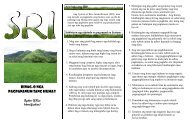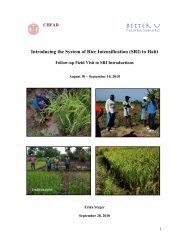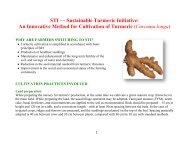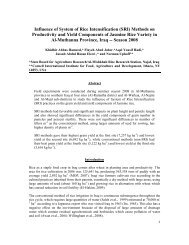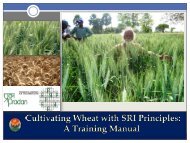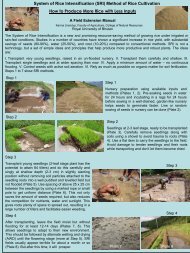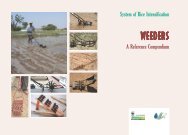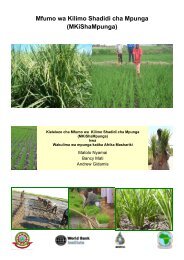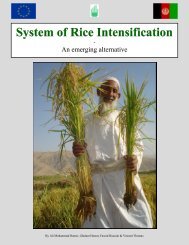EFFECT OF THE SYSTEM OF RICE INTENSIFICATION (SRI) ON ...
EFFECT OF THE SYSTEM OF RICE INTENSIFICATION (SRI) ON ...
EFFECT OF THE SYSTEM OF RICE INTENSIFICATION (SRI) ON ...
Create successful ePaper yourself
Turn your PDF publications into a flip-book with our unique Google optimized e-Paper software.
materials. These two chapters lead to chapter 4, 5 and 6 introducing <strong>SRI</strong>, Cambodian rice culture<br />
and development strategies in developing countries respectively. Chapter 7 and 8 introduce the<br />
target area in Cambodia and materials and methods applied in the field and laboratory for data<br />
collection respectively. Results are discussed and evaluated in chapter 9 and finally general<br />
conclusions are drawn in chapter 10.<br />
2. The role of Soil Organic Matter (SOM) in flooded rice soils<br />
2.1 Definition of SOM<br />
SOM can be defined as the sum of all organic matter (OM) in a soil, resulting from undecayed OM<br />
from plant tissues, soil microorganisms and animals, grasses, weeds, leaves and roots (Borggaard &<br />
Elberling, (2003). These different soil ingredients are part of different pools all responsible for the<br />
definition of SOM. The most important pools are i) the litter pool comprising e.g. crop residues, ii)<br />
light fraction - with root residues and iii) microbial biomass – the degradation of plant material<br />
(Stevenson & Cole, 1999). As all OM contains large percentages of C (Brady & Weil, 1999a) and<br />
in average SOM contains 58% C (Borggaard & Elberling, 2003). Roughly speaking can C in soils<br />
divided between two pools: Soil Organic Carbon (SOC) and Soil Inorganic Carbon (SIC) (Lal,<br />
2002). The SOC pool is composed of two very different fractions. The inert pool which does not<br />
comprise mineralization and is determined by climate, soil type and landscape position (Lal, 2006).<br />
The other pool is the labile pool which relies on management practices (Lal, 2006). The SOC pool<br />
comprising the labile factors can be influenced by management and there are direct effects on soil<br />
quality and the SOC content is linked to the labile pool (Lal, 2006). The labile pool is also<br />
interesting to focus on as it is near to the soil surface and possible GHG emissions will emit from<br />
this pool (Schlesinger & Andrews, 2000) and it has faster turnover rates of OM than the inert pool<br />
(Mandal et al., 2008). Mineralization is taking place in this pool and thereby the key to increase<br />
productivity is through SOC. This report measured the percentage of OM in the soils of Prey Veng,<br />
Cambodia. The terms, SOM, SOC, OM and C will all be used throughout this report to express the<br />
soil quality.<br />
13



